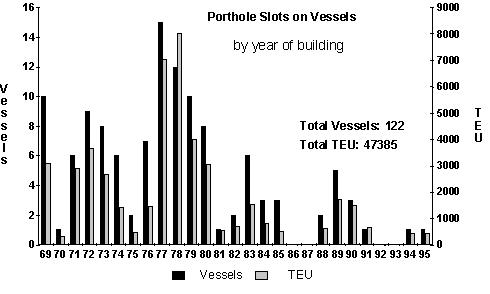 |
| Table 3: The most important shipping lines and routes for container ships with porthole containers |
The bar chart in Figure 10 clearly shows the various phases. From 1981 onward, only a small number of new vessels were built. As indicated above, the process started with the Australia service to Europe and the USA (1969-1977). This was followed by the South Africa-Europe service in 1977/78 and then the Caribbean-Europe services in 1977/79 (CAROL, CGM with bananas). The Europe-South America services were containerized between 1981 and 1985 and now serve the East and West Coasts. The new models supplied between 1981 and 1985 were intended for the Europe-South American East Coast service (EESCA) and the West Coast service (Eurosal).
 |
| Figure 10: Number of porthole ships built and number of porthole slots |
The Eurosal service began in 1984/85 with six ships for 130 x 40' porthole containers (260 PR-TEU) and 100 refrigerated container power outlets on deck for 40' integral refrigerated containers (200 IR-TEU). This signaled the new trend toward transitional ships with porthole containers below deck and integral containers on deck.
The new ships which were brought into service after 1984 were primarily replacements for older or unsuitable ships or additional ships needed to supplement and consolidate individual lines by offering more frequent voyages. This was caused by an increase in the volume of cargo and an improved infrastructure in the relevant countries in terms of road and rail transport of the containers inland. Only then could the benefits of containers in the closed cold chain be exploited in full.